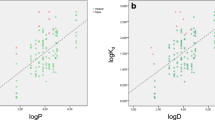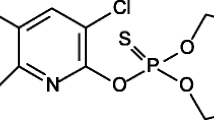Abstract
Nonlinear sorption of substituted phenols (degradation products of several pesticides) onto soils was often observed. This sorption nonlinearity at low solute concentration ranges could result in higher soil organic carbon-water distribution coefficient (K oc) values than those predicted by their hydrophobicity (K ow). In this study, nonlinear sorption characteristic of four substituted phenols (2,6-dimethylphenol, 2-chlorophenol, 2-nitrophenol, and 2,4-dichlorophenol) onto two agricultural soils was investigated. The sorption nonlinearity gradually approached apparent saturation at low solute activity ranges (e.g., a i < 0.01). At high a i ranges, linear sorption was observed. Thus, partition and adsorption of solutes were successfully evaluated by a dual-mode sorption model. The concentrations of substituted phenols in the environment are pretty low (e.g., usually lower than 1 mg/L). According to our results, nonlinear adsorption is dominant in such low concentration ranges in the environment. To predict varied log K oc values resulted from nonlinear adsorption, especially for low a i range, an expanded polyparameter linear free energy relationship (pp-LFER) is established: log K oc = [(1.829 ± 0.488) + (3.481 ± 0.462) log a i)]E+ [(− 4.307 ± 0.466) log a i]S+ [(− 0.876 ± 0.138) log a i]A+ [(− 0.086 ± 0.529) + (1.209 ± 0.218) log a i]B+ (6.280 ± 0.649)V – (6.814 ± 0.917) (E, the excess molar refraction; S, the dipolarity/polarizability parameter; A, the solute H-bond acidity; B, the solute H-bond basicity; and V, the molar volume). This model can provide a better prediction (within 0.3 log unit) than previous models. This study provides essential parameters for predicting and understanding the environmental behavior of substituted phenols in agricultural soils.

ᅟ





Similar content being viewed by others
References
Abraham, M. H. (1993). Scales of solute hydrogen-bonding: Their construction and application to physicochemical and biochemical processes. Chemical Society Reviews., 22, 73–83.
Abraham, M. H., Ibrahim, A., & Zissimos, A. M. (2004). Determination of sets of solute descriptors from chromatographic measurements. Journal of Chromatography A., 1037, 29–47.
Accardi-Dey, A., & Gschwend, P. M. (2002). Assessing the combined roles of natural organic matter and black carbon as sorbents in sediments. Environmental Science & Technology., 36, 21–29.
Aeschbacher, M., Brunner, S. H., Schwarzenbach, R. P., & Sander, M. (2012). Assessing the effect of humic acid redox state on organic pollutant sorption by combined electrochemical reduction and sorption experiments. Environmental Science & Technology., 46, 3882–3890.
Allen-King, R. M., Grathwohl, P., & Ball, W. P. (2002). New modeling paradigms for the sorption of hydrophobic organic chemicals to heterogeneous carbonaceous matter in soils, sediments, and rocks. Advances in Water Resources., 25, 985–1016.
Apul, O. G., Wang, Q., Shao, T., Rieck, J. R., & Karanfil, T. (2013). Predictive model development for adsorption of aromatic contaminants by multi-walled carbon nanotubes. Environmental Science & Technology., 47, 2295–2303.
Boyd, S. A. (1982). Adsorption of substituted phenols by soil. Soil Science., 136, 337–343.
Chen, B. L., Johnson, E. J., Chefetz, B., Zhu, L. Z., & Xing, B. S. (2005). Sorption of polar and nonpolar aromatic organic contaminants by plant cuticular materials: role of polarity and accessibility. Environmental Science & Technology., 39, 6138–6146.
Chiou, C. T., & Kile, D. E. (1994). Effects of polar and nonpolar groups on the solubility of organic compounds in soil organic matter. Environmental Science & Technology., 28, 1139–1144.
Chiou, C. T., & Kile, D. E. (1998). Deviations from sorption linearity on soils of polar and nonpolar organic compounds at low relative concentrations. Environmental Science & Technology., 32, 338–343.
Chiou, C. T., Cheng, J., Hung, W.-N., Chen, B., & Lin, T.-F. (2015). Resolution of adsorption and partition components of organic compounds on black carbons. Environmental Science & Technology., 49, 9116–9123.
Cornelissen, G., Gustafsson, O., Bucheli, T. D., Jonker, M. T. O., Koelmans, A. A., & Van Noort, P. C. M. (2005). Extensive sorption of organic compounds to black carbon, coal, and kerogen in sediments and soils: mechanisms and consequences for distribution, bioaccumulation, and biodegradation. Environmental Science & Technology., 39, 6881–6895.
Dolatto, R. G., Messerschmidt, I., Pereira, B. F., Martinazzo, R., & Abate, G. (2016). Preconcentration of polar phenolic compounds from water samples and soil extract by liquid-phase microextraction and determination via liquid chromatography with ultraviolet detection. Talanta, 148, 292–300.
Endo, S., & Goss, K. U. (2014). Applications of polyparameter linear free energy relationships in environmental chemistry. Environmental Science & Technology., 48, 12477–12491.
Endo, S., Grathwohl, P., Haderlein, S. B., & Schmidt, T. C. (2009). LFERs for soil organic carbon-water distribution coefficients (K-OC) at environmentally relevant sorbate concentrations. Environmental Science & Technology., 43, 3094–3100.
Fenner, K., Canonica, S., Wackett, L. P., & Elsner, M. (2013). Evaluating pesticide degradation in the environment: blind spots and emerging opportunities. Science, 341, 752–758.
Frankki, S., & Skyllberg, U. (2006). Chlorophenol binding to dissolved and particulate soil organic matter determined in controlled equilibrium systems. European Journal of Soil Science., 57, 655–664.
Fytianos, K., Voudrias, E., & Kokkalis, E. (2000). Sorption-desorption behaviour of 2,4-dichlorophenol by marine sediments. Chemosphere, 40, 3–6.
Gao, P., Feng, Y., Zhang, Z., Wang, C., Liu, J., & Ren, N. (2012). Kinetic and thermodynamic studies of phenolic compounds’ adsorption on river sediment. Soil & Sediment Contamination., 21, 625–639.
Goss, K. U., & Schwarzenbach, R. P. (2001). Linear free energy relationships used to evaluate equilibrium partitioning of organic compounds. Environmental Science & Technology., 35, 1–9.
Graber, E. R., & Borisover, M. (2005). Exploring organic compound interactions with organic matter: the thermodynamic cycle approach. Colloids and Surfaces a-Physicochemical and Engineering Aspects., 265, 11–22.
Haderlein, S. B., & Schwarzenbach, R. P. (1993). Adsorption of substituted nitrobenzenes and nitrophenols to mineral surfaces. Environmental Science & Technology., 27, 316–326.
Han, C., Zhang, H., Gu, Q., Guo, G., Li, Y., & Li, F. (2013). Toluene sorption behavior on soil organic matter and its composition using three typical soils in China. Environmental Earth Sciences., 68, 741–747.
Han, L. F., Sun, K., Jin, J., Wei, X., Xia, X. H., Wu, F. C., Gao, B., & Xing, B. S. (2014). Role of structure and microporosity in phenanthrene sorption by natural and engineered organic matter. Environmental Science & Technology., 48, 11227–11234.
Khan, Z., & Anjaneyulu, Y. (2005). Influence of soil components on adsorption-desorption of hazardous organics-development of low cost technology for reclamation of hazardous waste dumpsites. Journal of Hazardous Materials., 118, 161–169.
Li, B., Hu, X., Liu, R., Zeng, P., & Song, Y. (2015). Occurrence and distribution of phthalic acid esters and phenols in Hun River watersheds. Environmental Earth Sciences., 73, 5095–5106.
Liu, J.-C., Tzou, Y.-M., Lu, Y.-H., Wu, J.-T., Cheng, M.-P., & Wang, S.-L. (2010). Enhanced chlorophenol sorption of soils by rice-straw-ash amendment. Journal of Hazardous Materials., 177, 692–696.
Lu, Z., MacFarlane, J. K., & Gschwend, P. M. (2016). Adsorption of organic compounds to diesel soot: frontal analysis and polyparameter linear free-energy relationship. Environmental Science & Technology., 50, 285–293.
Nguyen, T. H., Goss, K.-U., & Ball, W. P. (2005). Polyparameter linear free energy relationships for estimating the equilibrium partition of organic compounds between water and the natural organic matter in soils and sediments. Environmental Science & Technology., 39, 913–924.
Plata, D. L., Hemingway, J. D., & Gschwend, P. M. (2015). Polyparameter linear free energy relationship for wood char-water sorption coefficients of organic sorbates. Environmental Toxicology and Chemistry., 34, 1464–1471.
Sagbas, S., Kantar, C., & Sahiner, N. (2014). Preparation of poly(humic acid) particles and their use in toxic organo-phenolic compound removal from aqueous environments. Water Air & Soil Pollution., 225, 1–10.
Schenzel, J., Goss, K. U., Schwarzenbach, R. P., Bucheli, T. D., & Droge, S. T. J. (2012). Experimentally determined soil organic matter–water sorption coefficients for different classes of natural toxins and comparison with estimated numbers. Environmental Science & Technology., 46, 6118–6126.
Schwarzenbach, R. P., & Westall, J. (1981). Transport of nonpolar organic compounds from surface water to groundwater. Laboratory sorption studies. Environmental Science & Technology., 15, 1360–1367.
Schwarzenbach, R. P., Escher, B. I., Fenner, K., Hofstetter, T. B., Johnson, C. A., von Gunten, U., & Wehrli, B. (2006). The challenge of micropollutants in aquatic systems. Science, 313, 1072–1077.
Selig, H., Keinath, T. M., & Weber, W. J. (2003). Sorption and manganese-induced oxidative coupling of hydroxylated aromatic compounds by natural geosorbents. Environmental Science & Technology., 37, 4122–4127.
Shih, Y. H., & Gschwend, P. M. (2009). Evaluating activated carbon-water sorption coefficients of organic compounds using a linear solvation energy relationship approach and sorbate chemical activities. Environmental Science & Technology., 43, 851.
Tremolada, P., Guazzoni, N., Smillovich, L., Moia, F., & Comolli, R. (2012). The effect of the organic matter composition on POP accumulation in soil. Water Air and Soil Pollution., 223, 4539–4556.
Xiao, J., Xie, Y., Han, Q., Cao, H., Wang, Y., Nawaz, F., & Duan, F. (2016). Superoxide radical-mediated photocatalytic oxidation of phenolic compounds over Ag+/TiO2: influence of electron donating and withdrawing substituents. Journal of Hazardous Materials., 304, 126–133.
Acknowledgments
This study is supported by the National Natural Science Foundation of China (No. 41472231) and the Fundamental Research Funds for the Central Universities (2652017182) . We thank the anonymous reviewer for valuable comments on the manuscript.
Author information
Authors and Affiliations
Corresponding author
Electronic supplementary material
ESM 1
(DOCX 245 kb)
Rights and permissions
About this article
Cite this article
Yu, C., Bi, E. Evaluating Nonlinear Sorption of Four Substituted Phenols to Agriculture Soils Using Expanded Polyparameter Linear Free Energy Relationship. Water Air Soil Pollut 228, 414 (2017). https://doi.org/10.1007/s11270-017-3596-x
Received:
Accepted:
Published:
DOI: https://doi.org/10.1007/s11270-017-3596-x




